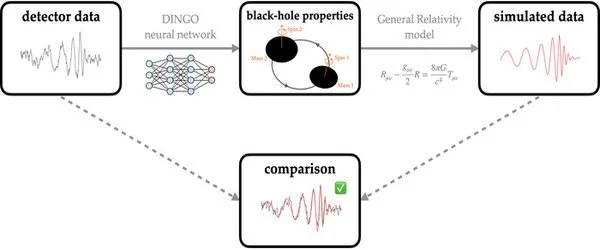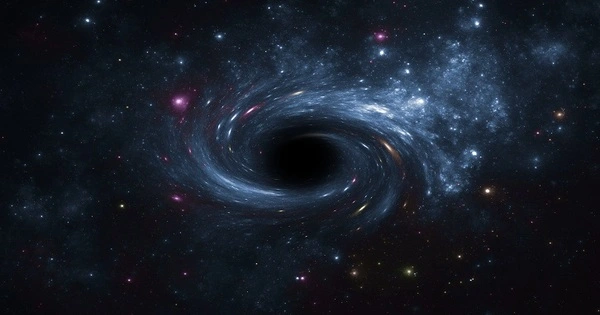Analyzing coalescing black holes is a difficult task that necessitates sophisticated machine-learning techniques. A safety net, a type of neural network specifically designed for detecting rare events, is one reliable approach for this task.
An interdisciplinary team has created an algorithm that instantly checks its own calculations of the properties of merging black holes and corrects its result if necessary – cheaply and quickly. The machine learning method provides extremely accurate information about gravitational waves observed and will be ready for use when the global network of gravitational-wave detectors begins its next observing run in May.
When two black holes collide, they produce gravitational waves that travel at the speed of light through space and time. When these signals reach Earth, they can be detected by large detectors in the United States (LIGO), Italy (Virgo), and Japan (KAGRA). Scientists can then determine the properties of the black holes by comparing them to theoretical predictions: masses, spins, orientation, position in the sky, and distance from Earth.
A team of researchers from the Max Planck Institute for Intelligent Systems (MPI-IS) in Tübingen and the Department of Astrophysical and Cosmological Relativity at the Max Planck Institute for Gravitational Physics (Albert Einstein Institute/AEI) in Potsdam has developed a self-checking deep learning system that extracts information from gravitational-wave data with high accuracy.
During the process, the system validates its own predictions about the parameters of merging black holes – a deep neural network with a safety net. The algorithm successfully analyzed a set of 42 detected gravitational waves from merging black holes: When compared to computationally expensive standard algorithms, the results were indistinguishable. The research was published in the journal Physical Review Letters.
We can guarantee the accuracy of our machine learning method, which is almost never the case in deep learning. As a result, the scientific community is more likely to use the algorithm to analyze gravitational-wave data.
Alessandra Buonanno
DINGO: a deep neural network for gravitational-wave analysis
Deep learning safety net models are trained on a large dataset of background events as well as a smaller dataset of rare events (in this case, coalescing black holes). The network has been trained to recognize the distinctive features of rare events, allowing it to distinguish them from background noise.
The researchers have developed a deep neural network called DINGO (Deep INference for Gravitational-wave Observations) to analyze the data. DINGO has been trained to extract – or infer – the gravitational-wave source parameters from the detector data. There was a press release on this in December 2021. The network learned to interpret real (observed) gravitational-wave data after training with many millions of simulated signals in different configurations.

Fig: Casting a safety net – A reliable machine learning approach for analyzing coalescing black holes
Trust, but verify
However, it is impossible to tell whether the deep neural network is correctly reading the information at first glance. One drawback of common deep learning systems is that their results sound plausible even when they are incorrect. That’s why MPI-IS and AEI researchers added a control feature to the algorithm. “We developed a network with a safety net,” says Maximilian Dax, a doctoral student in the Department of Empirical Inference at MPI-IS and the publication’s first author.
First, the algorithm uses the measured gravitational wave signal to calculate the properties of the black holes. A gravitational wave is modeled and then compared to the original observed signal using these calculated parameters. The deep neural network can thus cross-check its own results and correct them in case of doubt.”
The algorithm controls itself, making it much more reliable than previous machine learning methods. But not only that. “We were surprised to discover that the algorithm is often able to identify anomalous events, namely real data inconsistent with our theoretical models. This information can be used to quickly ‘flag’ data for additional investigation,” says Stephen Green, co-lead author, and former Senior Scientist at the AEI (now at the University of Nottingham).
“We can guarantee the accuracy of our machine learning method, which is almost never the case in deep learning. As a result, the scientific community is more likely to use the algorithm to analyze gravitational-wave data,” says Alessandra Buonanno, author and director of the AEI’s Department of Astrophysical and Cosmological Relativity. Scientists from all over the world are studying gravitational waves in large collaborations like the LIGO Scientific Collaboration (LSC), which includes over 1,500 researchers.
Bernhard Schölkopf, who is a Director at MPI-IS, adds: “Today, DINGO analyzes gravitational-wave data — but such a self-controlling and self-correcting method is also interesting for other scientific applications where it is crucial to be able to corroborate the correctness of ‘black-box’ neural network methods.”





